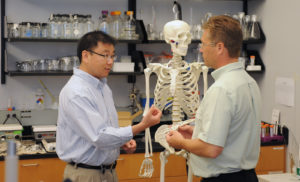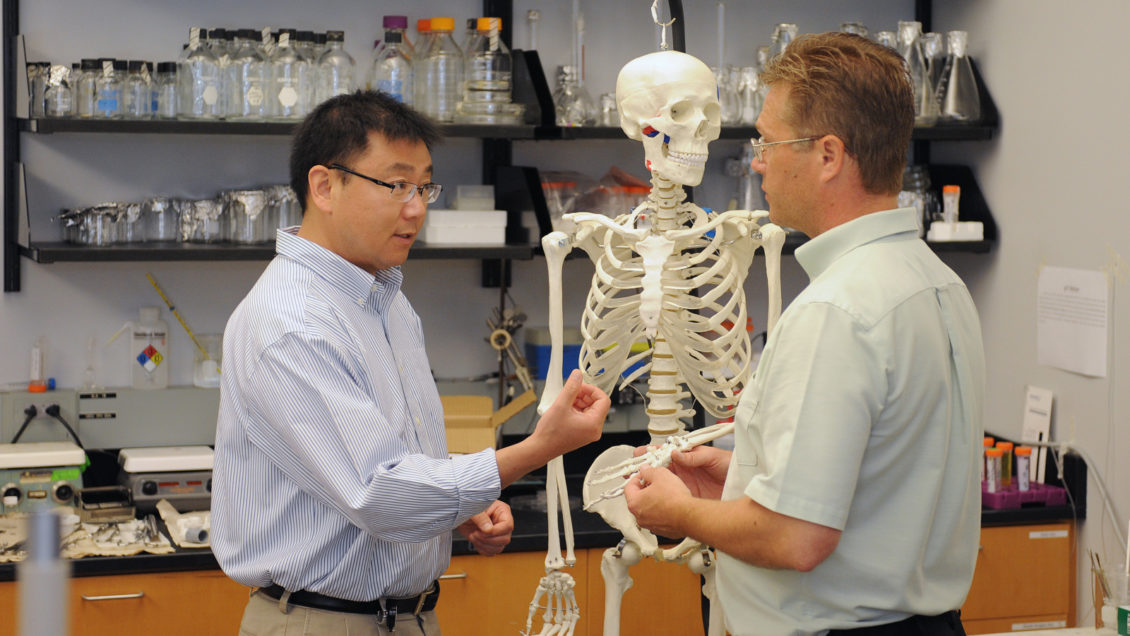South Carolina is strengthening its position as a hub for high-impact biomedical research with a new multi-million-dollar project that undergirds the long-standing partnership between Clemson University and the Medical University of South Carolina (MUSC) and loops in crucial support from the National Institute of Dental and Craniofacial Research (NIDCR) at the National Institutes of Health (NIH).

Researchers will study temporomandibular joint (TMJ) function, how the TMJ functions in different craniofacial developmental disorders that seem to put the joint at risk for degeneration and how the joint responds to surgical correction of these disorders, researchers said.
The TMJ makes it possible to move the lower jaw to eat and talk. Understanding the stresses on the TMJ before temporomandibular joint disease (TMD) occurs will unlock the mechanisms that put certain individuals at risk for TMD.
The focus of the research aligns with the recommendations made by an ad hoc committee on temporomandibular disorders that was formed under the auspices of the National Academies of Sciences, Engineering, and Medicine’s Health and Medicine Division.
Four of the researchers involved in the new project are connected to the Clemson-MUSC Bioengineering Program. As part of the program, Clemson bioengineering faculty and students are based at MUSC’s Charleston campus where they collaborate closely with MUSC researchers and clinicians.
The new project, funded by a $3.18-million U01 grant from NIDCR, has two principal investigators. Hai Yao, serves as the Ernest R. Norville Endowed Chair and professor of bioengineering at Clemson, professor of oral health sciences at MUSC, the associate department chair for the Clemson-MUSC Bioengineering Program and a member of the national temporomandibular disorder ad hoc committee. Janice Lee is the clinical director of the NIDCR and chief of the Craniofacial Anomalies and Regeneration Section within the NIH intramural research program.
Yao said the project is possible only because of the synergy and complementary strengths of Clemson, MUSC and NIDCR.
“Clemson and MUSC work together so seamlessly it’s as if we are one university, and we both collaborate closely with NIDCR,” he said. “This project is the latest example of how these strategic partnerships are making South Carolina a hub of biomedical research that is recognized globally. Through these partnerships, we are well positioned to address urgent healthcare needs identified by the NIDCR and the National Academy of Medicine.”
Lee said the researchers are uniquely positioned for success.
“The U01 is an extremely competitive grant that requires intra- and extra- mural collaboration utilizing the world-renown resources at the NIH Clinical Center,” Lee said. “It is extra special as this is a first for NIDCR intramural as well. Temporomandibular joint disorders are debilitating conditions, and I am thrilled to be working with Hai Yao and his team to truly move the research forward. His team brings outstanding bioengineering technology to examine craniofacial musculoskeletal function to the Clinical Center; our discoveries will be translated and, ideally, will initiate first-in-human therapies for TMD at the NIH.”
Lee continued: “NIDCR is committed to working with world-class partners such as Clemson and MUSC to advance translational research into temporomandibular disorders. This project will help improve understanding of these disorders, thereby improving outcomes for patients.”
This is particularly important to Lee as she is the oral and maxillofacial surgeon who will be providing the surgical treatments and is acutely aware of the impact that surgery can have on TMD, she said.
Özlem Yilmaz, chair of the Department of Oral Health Sciences at MUSC, said the new project presents an important venue to help patients debilitated with TMJ disorders and underpins South Carolina’s leading position in temporomandibular disorders research.
“New measurement tools and computational models will be tested on patients at the NIH Dental Clinic,” Yilmaz said. “These novel technologies, stemming from more than a decade of teamwork bringing together bioengineers, oral surgeons, and oral biologists at MUSC and Clemson, will push the boundary of the current temporomandibular disorders research.”
Sarandeep Huja, dean of the College of Dental Medicine at MUSC, said the new project further solidifies MUSC’s partnership with Clemson and NIDCR.
“This partnership will help us innovate the future of oral health and wellness,” Huja said. “We will not only be advancing knowledge of temporomandibular disorders but also expanding knowledge for the next generation of oral health providers and researchers. As a practicing clinician and orthodontist, I frequently encounter patients with temporomandibular disorders, in the very type of patients that will be recruited in this study. It is critical we find evidence based treatments for these patients.”
The vice presidents of research at Clemson and MUSC are crucial to the institutions’ partnership, Yao said. Tanju Karanfil is vice president of research at Clemson, and Lori L. McMahon is vice president for research at MUSC.
“We look forward to solidifying the strong foundation that Clemson and MUSC have built,” Karanfil and McMahon said in a joint statement. “These large, high-impact projects are advancing knowledge and creating a new generation of talent, while strengthening the state’s national and international reputation for biomedical research and education.”
Researchers are calling their project “Assessment of Temporomandibular Joint Morphology, Mechanics, and Mechanobiology in Class II and III Target and Surgical Phenotypes.”
Part of what makes the project unique is the collaboration that maximizes the expertise of the investigators.
“Dr. Lee and her craniofacial team at NIDCR will recruit the large number of patients that will be required for the research, characterize the patients, and support their travel and treatment costs,” Yao said.
Clemson and MUSC will perform analysis of temporomandibular joint biomechanics and mechanobiology and put that information into context to better understand patients’ health status and the potential for future problems
Martine LaBerge, chair of Department of Bioengineering at Clemson, said the U01 grant that funds the new project is the first of its kind at Clemson.
“This grant is a testament to the strength of the biomedical research enterprise that Clemson and MUSC are building in partnership with federal collaborators, especially the National Institutes of Health,” she said. “Dr. Yao’s leadership has been crucial to the partnership’s success, and it remains in good hands with him at the helm.”
The project is the latest major NIH grant led by Yao. He is also principal investigator on South Carolina Translational Research Improving Musculoskeletal Health (SC TRIMH), a Center for Biomedical Research Excellence that was founded with an $11-million NIH grant in 2018. Researchers associated with the center have accounted for $8 million in NIDCR awards over the past year.
Anand Gramopadhye, dean of the College of Engineering, Computing and Applied Sciences, said the success underscores the high quality of research that has come out of interdisciplinary partnerships such as the Clemson-MUSC Bioengineering Program.
“Working together in collaboration with federal partners is elevating South Carolina’s position as a place for top-tier biomedical research and predoctoral and postdoctoral education,” he said. “Dr. Yao and his team have built a high-impact program and are continuing to climb. I offer them my whole-hearted congratulations.”
END
NIH grant number U01DE031512 funds this project.
Get in touch and we will connect you with the author or another expert.
Or email us at news@clemson.edu

